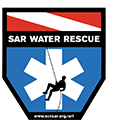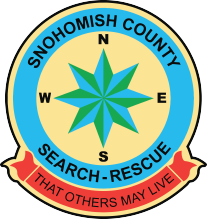
About
The Swiftwater Rescue Team needs your support!
Among its other technical rescue specialties, Search & Rescue in Snohomish County, Washington, includes a dedicated team that is trained and equipped to perform searches and rescues in our hazardous water environments.
Waterways in Snohomish County are scenic destinations, offer excellent recreation opportunity, and are critical to the environment. But water features can be as dangerous as they are magnificent. Before going in or near water, particularly moving water, everyone should understand area hazards, and be properly trained & equipped to avoid or deal with those hazards. Area hazards can include rocks or other fixed obstacles, branches or other entanglements, strainers, turbulent or submerged currents, cold water, and nearby watercraft.
Like other elements of Search & Rescue, the Water Rescue Team is on call 24/7, including a designated “Water Rescue Coordinator” to ensure the proper equipment and personnel arrive on scene as needed. The Water Rescue Team is made up entirely of volunteers who dedicate considerable time and effort to being well trained and equipped so that we can perform our rescue mission when called upon to help others in our community.
In Snohomish County, the SAR Water Rescue Team is a critical component of emergency response to flood conditions. Flood waters are extremely dangerous, and should not be entered by anyone other than properly trained and equipped rescuers. Citizens living or traveling in potential flood areas should monitor local flood information, and follow evacuation orders. When you evacuate before becoming trapped, it is safest for your family, and safest for our rescue team.
Within constraints of being funded entirely by donations, SAR in general, and the Water Rescue Team in particular drive to establish the most capable set of rescue assets to be effective in our rescue mission while maintaining rescuer safety. Because missions and training are demanding on equipment as well as team members, we spend quite a bit of additional time and effort keeping our precious tools rescue-ready.
SAR has several levels of water-related training, both for Water Rescue Team members and more basic levels for other SAR members. We are constantly challenged to keep our skills sharp with all our equipment, and in the widely varied conditions we see in rescue missions. Team members combine extensive rescue training with other water-related experience such as scuba diving, whitewater kayaking, rafting.
The nature of water rescue is that we must train in the same hazardous environment in which we work – there is no such thing as completely safe swiftwater! High level of hazard, widely varied conditions, and perishable skills demand frequent training both for effective rescue and to keep our rescuers safe. As a small team that trains together frequently, we become confident placing our lives in our teammates hands. This makes us both safe and effective when its mission time.
To manage the considerable risk inherent to working around water (often aggravated by darkness and poor weather), the SAR Water Rescue Team relies extensively on training, procedures and checklists. Safety is absolutely paramount in everything we do. Besides “practicing what we preach,” we participate in several community events to increase awareness of water safety issues.
In addition to direct search for, or rescue of individuals who are trapped or missing, the SAR Water Rescue Team also works as part of larger SAR missions to provide water crossing, over-water transport, or downstream safety for other SAR teams.
Water features of Snohomish County, Washington
Snohomish County includes portions of three major river systems and their hundreds of tributaries, many dozens of lakes (some quite remote), coastline along Puget Sound, and multiple islands. Each of these can present a demanding rescue environment, changing with seasonal conditions, weather and other factors. Rescue situations range from top-end whitewater to mountain rivers to mudflats to waterfalls to remote mountain lakes to floodwater to ice, often complicated by darkness, poor visibility and difficult access.
In many parts of Snohomish county, flooding is a recurring threat every year, and a recurring event during many years. Flood-related information and conditions are available from Department of Emergency Management. NOAA also has an excellent forecasting website for area flood conditions. Pay attention to conditions and evacuate when you are so directed. Virtually everyone we rescue during flood conditions has either declined to evacuate when directed, or has chosen to go out into floodwaters, or both. Don’t!
The busiest recreational use of Snohomish County waterways happens from mid-spring through late summer. Use caution while swimming in open water, and with any watercraft, including canoe and inflatable tubes or rafts. Be sure that you are adequately prepared, including life jacket, shoes, and water-tolerant light source. Like any outdoor adventure, let someone you trust know where you are going and when you expect to return.
If you are reporting an emergency, dial 911. If someone may require rescue from the water or near water, describe the location as best you can. Be as clear as possible whether people are stranded in the water, near water, or might need to be accessed from the water. Include the nature of any medical emergency as best you know it.
SAR Water Rescue Team and its Membership
Search & Rescue has a wide variety of opportunities for members of our community who are interested in volunteering to help others in their community. The process for joining Search & Rescue is straightforward, and it opens an array of technical specialties for those who are interested.
Water Rescue Team members are selected from experienced SAR members who have a high response rate for SAR missions, have advanced their technical skills, and have consistently demonstrated solid tactical judgment under stress. Because of the demanding initial and recurring training requirements for Water Rescue, we use a competitive selection process to fill a very limited number of the following positions:
– Hovercraft pilot
– Hovercraft crew (does most of the actual searching & direct rescue from craft)
– Rescue Swimmer (work in most dangerous water & make contact rescues)
– Ground Support (manage launch/landing site & operate rigging systems)
Continuing qualifications for these positions are reviewed on a 120-day cycle, along with candidacy of SAR members who have expressed an interest in joining the Water Rescue Team.
SAR members interested in joining Water Rescue Team can contact the SAR Water Rescue Coordinator directly (see our “contacts” section below), or through another Water Rescue Team member, perhaps one in your SAR unit. Be prepared to discuss (among many other things) your SAR mission response history, rope rescue training, medical training, and other water-related experience outside of SAR. Remember that the positions on the SAR Water Rescue Team are fixed in number and are filled competitively – to get one you simply need to be better at it than whoever has that position today. And then to keep that position…
SAR Water Rescue Equipment
All of Search & Rescue’s Water Rescue equipment is funded by donations from individuals, businesses, and community organizations. Equipment is selected to balance our limited resources with the potential benefits to those we rescue and the safety of our rescuers.
Key Water Rescue Team equipment
(inside dedicated Water Rescue vehicle or towed)
2 Rescue HovercraftCataraft inflatable
Oceanid RDC inflatable
River Boards
Waterproof lights
Large spotlights
Underwater camera
Water-related rope rescue gear
Line crossing devices
Throwbags (various lengths)
PFDs (infant to super-size adult)
K9 PFD
Water-compatible litters
Survival gear for subjects
Medical kits, oxygen & AED
Portable and mobile radios
Tools, spare parts & support equip
Launch site and area hazard info
SAR Water Rescue Participation in Community Events
An important of our Search & Rescue mission is community education. Besides being a valuable community member, these efforts hope to prevent rescue calls that might otherwise have occurred. The SAR Water Rescue Team participates in many such events each year, with the hovercraft static display most popular.
Besides “practicing what we preach,” we participate in several community events to increase awareness of water safety issues.
Night Out Against Crime
Snohomish Pumpkin Festival
Various events with local school districts
Many Safety Fairs (or similar events) throughout the year
Community parades or similar festival events
Snohomish Pumpkin River Race
Make donations to support SAR Water Rescue Team
Search & Rescue is funded by tax-deductible contributions from individuals, businesses, and organizations throughout our community. Several of these contributors have elected to designate their donation as intended to support our Water Rescue program.
For anyone so inclined, simply make a notation on your donation that you would like all or a portion of your donation to support the future of SAR Swiftwater Rescue Team.
Thank you to the many members of our community who make financial contributions so that Search & Rescue can perform our mission.
Contacts
Certain members of the SAR Water Rescue Team can be reached if someone has questions about this program. We receive a “steady diet” of questions from our own SAR members, similar agencies in other areas, and others.
We will make every effort to reply as soon as possible.
Water Rescue Coordinator (General Water Rescue Team information, policy issues, etc)
water-rescue6@scvsar.org
Equipment (including hovercraft)
water-rescue5@scvsar.org
Ground Support Team Members
water-rescue4@scvsar.org
Rescue Swimmers
water-rescue3@scvsar.org


 Donate
Donate